When most people picture landscapes of wildflowers, they often picture bright pastels of yellow, blue, and pink against a backdrop of prairie grass. Others may think of the chorus of spring ephemerals blooming in the understory of the woods. Folks from the west coast may even imagine a blanket of desert annuals blooming in synchrony after a rare summer rain. I, on the other hand, think of a rock.
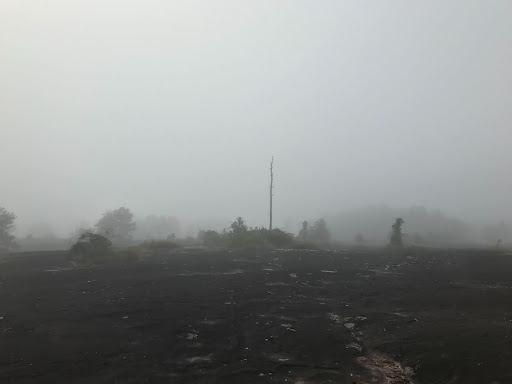
Throughout the Piedmont Plateau (the area situated between coastal plains and the Appalachians) – hidden amongst deciduous forests, vast swathes of prairie, rows of pine plantation, and human development – are “islands†of exposed rock known as granite and gneiss outcrops and flatrocks (I will use “granite outcrops†to refer to all the rocks I talk about in this piece, though Piedmont granite and gneiss outcrops differ in their chemical composition). Outcrops are 300-350 million years old, formed by the hardening of molten granite, which over time was exposed from erosion of the softer rocks that initially surrounded them. Some outcrops are massive conspicuous domes, like Arabia mountain, while others remain hidden, like the Rock and Shoals flatrock in Athens. Despite their variation in chemistry and size, one thing unites all outcrops: a distinct community of whimsical plants.
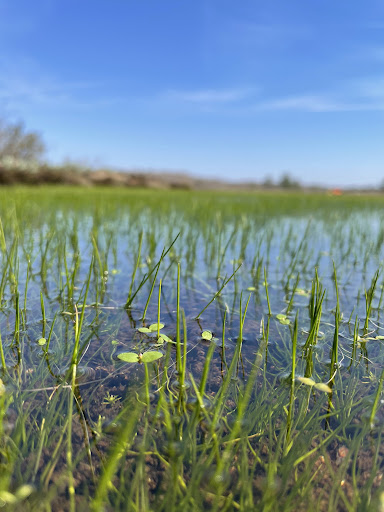
The first question that probably comes to mind is, “how the heck does a rock support a bustling community of plants?†And that's fair. The answer is in the soil; plants don't live directly on rocks but instead colonize depressions in the rock that fill with water and soil, which are called pools. Pools form over long periods of time when exposed granite becomes weathered, filling small depressions with small chunks of rock and sand. Some of these depressions have edges that hold rainwater, and after rainfall events, they become little swimming holes for plants and semiaquatic animals like frogs and insects. Many generations of plants die in these pits, and their decomposition turns the thin sandy soils into deeper, darker soil full of organic matter. This process continues over centuries, and eventually, some pools in areas with high levels of water runoff become so large and deep that trees can colonize them.
As fun as it sounds, the species that live on outcrops aren't just there to enjoy a relaxing day at the pool. In fact, granite outcrops are incredibly harsh environments, and the species that live on them have special adaptations that allow them to persist in the harsh outcrop pools. Specifically, outcrops are incredibly hot (imagine how hot a rock gets in 100-degree heat), have nutrient-poor soils, and have limited of water availability. To avoid these stressors, many species simply grow when the temperature is low and the water is plentiful; these species are called winter annuals, and they are the cornerstone of spring on granite outcrops.
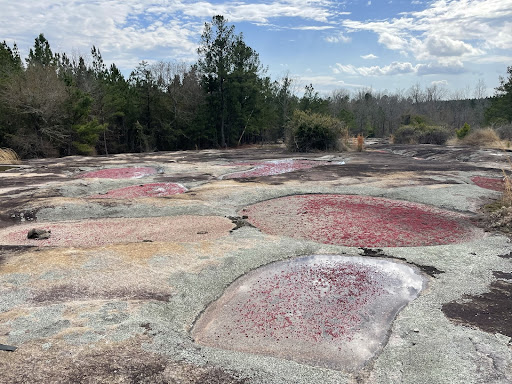
One of the showier winter annuals is elf orpine (Diamorpha smallii), which are tiny red succulents that occupy shallow, sandy pools and cracks in granite outcrops. If you're thinking elf orpine just adds a “splash of red†to a drab rock, you'd be wrong; these tiny plants congregate in the thousands to produce seas of crimson. Elf orpineflowers in late February and March, adding a splash of white (this time actually a splash) to the crimson sea. To ants, these flowers are actually like a sea of gold, as ants collect nectar from these tiny flowers in exchange for pollinator services. Elf orpine, like many granite outcrop species, is endemic only to granite outcrops, meaning it can only persist in granite outcrop pools. If you're keen on seeing this incredible outcrop display, which I highly recommend, you would be hard-pressed to find any Diamorpha past late April, so plan your trips accordingly!
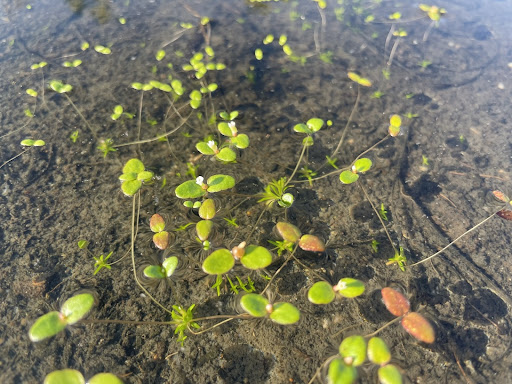
In addition to seas of hundreds of thousands of teeny plants, granite outcrops are home to several species of conservation concern. This includes the true star of the tiny, wet circus: snorkelwort. That's right – a plant with a snorkel. Snorkelwort (Gratiola amphiantha) persists in pools that have big rims and thin soil and hold water following precipitation. Each snorkelwort is rooted in the soil of a pool and produces four leaves just at the top of the soil. From there, it sends up snorkels to the surface of the water, each of which produces two leaves that sit on the water surface (think miniature lily pads). Between these leaves is a minuscule flower, smaller than a pencil eraser, for insects to pollinate. As cute as they are, snorkelwort needs very specific pool types to live, and this specific pool type tends to be rare on most outcrops. As such, snorkelwort is listed as a threatened species by the U.S. Fish and Wildlife Service. Alongside snorkelwort in these rare pools are two species of endangered quillwort (Isoetes melanospora and Isoetes tegetiformans). These species do not flower, but they form lush mats of vegetation that feel like a tiny, flooded jungle against an otherwise beige backdrop. If you want to visit any of these rare species, snorkelwort flowers in early spring (at a similar time to elf orpine) and the Isoetes species form lush mats whenever rain fills their little pools.
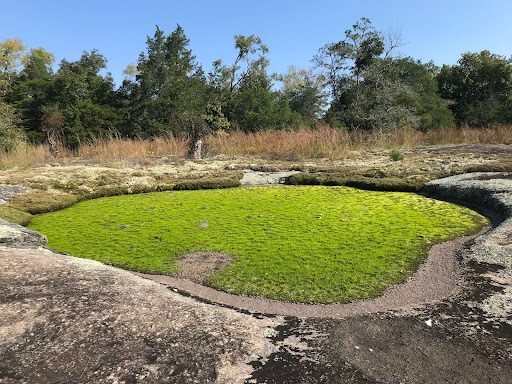
Sadly, granite outcrops have been subject to a historical and ongoing regime of quarrying, which has been a massive contributor to the decline of granite outcrop species. Quarrying rocks the world of these rare outcrop species by destroying their pristine pool habitat and leaving open rock with no pools for the rare plant species to colonize. Further, climate change is altering the already stressful granite outcrop environment, thus pushing rare granite outcrop species closer to extinction. Taken together, human activities are forcing these rare species between a rock and a hard place. Without them, granite outcrops would return to the bland rock they once were. Conservation actions, such as protecting granite outcrops and reducing carbon emissions, are necessary so snorkelworts and quillworts don't hit rock bottom and can be enjoyed by future generations.
I implore you – don't take these rare habitats for granite. You never know what gems you may find in a pile of rocks.
Featured image: “Granite Outcrop with Vernal Pool” by librarynerd is marked with CC BY-NC 2.0.
About the Author
Riley is a PhD student in the Department of Plant Biology. He received his B.A. in honors biology from Gustavus Adolphus College in Saint Peter, MN. Riley's research aims to understand how habitat fragmentation and climate change influence plant conservation through effects on the ecology and evolution of populations. Currently, his research highlights how climate change is affecting stress-adapted plant populations on Georgia's granitic outcrops. If he's not in the field doing his research, you'll find Riley watching marble races.
-
Riley Thoenhttps://athensscienceobserver.com/author/riley-thoen/






